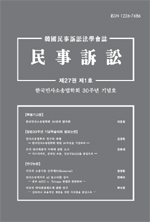키워드
초록
Among the four systems of intervention in litigations, the first to appear in the Civil Procedure Code is “auxiliary intervention,” and the provisions related to it are generally applied to other forms of intervention as well. Auxiliary intervention refers to a situation where a third party with an interest in the outcome of a litigation participates in the case to help one of the parties win the litigation. One of the requirements for auxiliary intervention is the existence of a legal interest in the litigation outcome, which is the main theme of this research. There is a scholarly debate about whether the legal interest in the litigation outcome pertains only to the judgment’s main text (the subject of the litigation) or whether it also includes the reasoning behind the judgment. The purpose of this study is to re-examine the meaning of the litigation outcome, which forms the basis of the legal interest, a crucial issue when determining the benefit of auxiliary intervention. In reviewing Dr. Lee Si Yoon’s viewpoint, I sought to shed new light on it by comparing domestic legal theories and case law, as well as the situation in Japanese law, which has greatly influenced Korean law. I think that the litigation outcome should be understood as the entire judgment, not just the main text of the judgment. Interpreting it narrowly, limiting it to the main text, is a very rigid interpretation that may not effectively respond to the changes of the times. Dr. Lee’s many viewpoints, especially those regarding the benefits of auxiliary intervention, were a significant challenge or barrier that later academic theories needed to overcome. Although Dr. Lee’s viewpoint remains powerful, it may eventually change. I look forward to the development of active discussions on the benefits of auxiliary intervention in the future.
목차
Ⅰ. 들어가며
Ⅱ. 이시윤 박사의 견해
Ⅲ. 판례와 학설의 전개
Ⅳ. 일본법의 대응
Ⅴ. 나오며
참고문헌 (0)
등록된 참고문헌 정보가 없습니다.
해당 권호 수록 논문 (0)
등록된 수록 논문 정보가 없습니다.
